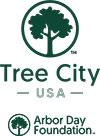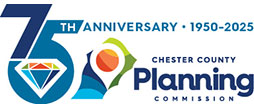Tree and Forest Maintenance and Stewardship
Healthy trees and woodlands play a critical role in environmental sustainability, community well-being, and biodiversity. Selecting the right native species and properly maintaining them are essential for their long-term survival. Native trees are well adapted to local soils and climates, making them more resistant to insects and diseases while requiring less watering and fertilizing than non-native species. They also provide better habitat, cover, and food sources for wildlife and pollinators.
Non-native plants exhibit invasive growth patterns and can reproduce prolifically, potentially harming the environment, economy, and sometimes human health. The high population of white-tailed deer in this region presents another challenge to maintaining newly planted trees, as deer browsing can damage or kill young trees before they become established. (See Additional Resources for more information on native plants, invasive species, and addressing deer browse.)
Proper tree selection, planting, and maintenance help mitigate these challenges and ensure the health and longevity of tree populations. Resources such as the PHS Tree Tenders, TreeVitalize, and Penn State Extension provide valuable guidance for individuals and municipalities regarding best practices for tree care. Programs like Tree City USA promote sustainable urban forestry, while other resources address tree mortality, hazard tree management, and invasive species control.
By using the following programs, resources, and tools, communities and landowners can make informed decisions that support resilient, thriving tree populations, from planting through maturity.
Planting and Maintaining New Trees
PHS Tree Tenders

The PHS Tree Tenders Program offered through the Pennsylvania Horticultural Society (PHS) trains community members how to select, plant, and maintain street trees and yard trees.
TreeVitalize
 TreeVitalize, in a public-private partnership with DCNR, developed this Guide to Tree Selection, Planting and Care. The guide includes valuable information on tree and site selection, preparing the planting site, best planting practices, caring for trees, and diagnosing tree problems. The guide also discusses tree commissions, street tree ordinances, and includes tree lists noting size and characteristics.
TreeVitalize, in a public-private partnership with DCNR, developed this Guide to Tree Selection, Planting and Care. The guide includes valuable information on tree and site selection, preparing the planting site, best planting practices, caring for trees, and diagnosing tree problems. The guide also discusses tree commissions, street tree ordinances, and includes tree lists noting size and characteristics.
See the Tree Protection and Replacement Ordinance Standards page for ordinances that work well in urban areas and include protections for public and larger trees on private property.
Tree City USA
 The Arbor Day Foundation's Tree City USA program promotes sustainable urban forestry practices in communities across the country. To achieve Tree City USA status, municipalities must:
The Arbor Day Foundation's Tree City USA program promotes sustainable urban forestry practices in communities across the country. To achieve Tree City USA status, municipalities must:
- Create a tree board or department
- Adopt a tree ordinance
- Maintain a community forest program with an annual budget of at least $2 per capita
- Observe Arbor Day with a proclamation and celebration
There are over 100 official Tree Cities in Pennsylvania. See the Pennsylvania Tree City fact sheet for more information.
Penn State Extension
Penn State Extension offers abundant resources to help you properly select and plant trees. These resources provide information on the characteristics of planting sites and soil types, tree species' tolerances, and growth characteristics to help you choose appropriate tree species for the conditions and the benefits you want to receive from the trees.
- Tree Selection and Planting
- Helping Municipalities and Tree Commissions — Manage Community Trees
- Plant with Care
- Planting Aftercare Webinar: Essential to Tree Establishment and Survival (webinar)
For more extensive comprehensive tree planting projects, see Developing a Tree Planting Plan for Your Community Project, which provides helpful tips for creating a community tree planting plan.
Resources for Tree Mortality and Replacement
Monitoring and Addressing Hazard Trees
Hazard trees pose a risk to people and infrastructure. Having a hazard tree monitoring program can help identify and manage these risks. WeConservePA's Developing a program for monitoring and addressing Hazard Trees provides guidance on hazard tree monitoring programs.
Resources for Diseased, Dying, and Dead Trees
The following provides resources for identifying diseased and pest-damaged trees, what to do about dead and dying trees, and for tree replacement.
Pest-Infected and Diseased Trees
Forest insects and diseases are serious threats and can have devastating impacts on the long-term health and sustainability of forest ecosystems. The insects and diseases that have caused the most damage to our County trees and forests in recent years include:
- Hemlock Wooly Adelgid (DCNR)
- Emerald Ash Borer (DCNR)
- Beech Bark Disease (DCNR)
- Beech Leaf Disease (Penn State Extension)
- Oak Wilt (Penn State Extension)
For more information on these infestations and diseases, visit the DCNR website on Forest Insects and Diseases. The Penn State Extension also provides numerous articles, webinars, and guides to identify and manage pests and diseases.
Dying and Dead Trees
Dead parts of live trees and dead trees, whether standing or fallen, are essential to the health of growing forests and wildlife habitats. The Penn State Extension article, Dead Wood for Wildlife, explains the value and use of dead wood and cavity trees and management considerations for harvesting dead wood.
WeConservePA provides a Tree Law in Pennsylvania guide that offers legal insights on typical neighbor disputes and responsibilities concerning trees near property lines.
Replacement Trees
When trees in southeastern Pennsylvania forests die and leave gaps in the canopy, invasive species can enter the woodland and spread. Replacing dead and dying trees with new ones is essential for maintaining healthy woodlands. For information on replacing trees removed during the development process, see the Tree Protection and Replacement Ordinance Standards page.
- For examples of standards related to tree replacement, see the Tree Protection and Replacement Ordinance Standards page.
- Visit the Funding Sources and Programs page for a list of grants that help fund tree planting projects and reforestation.

